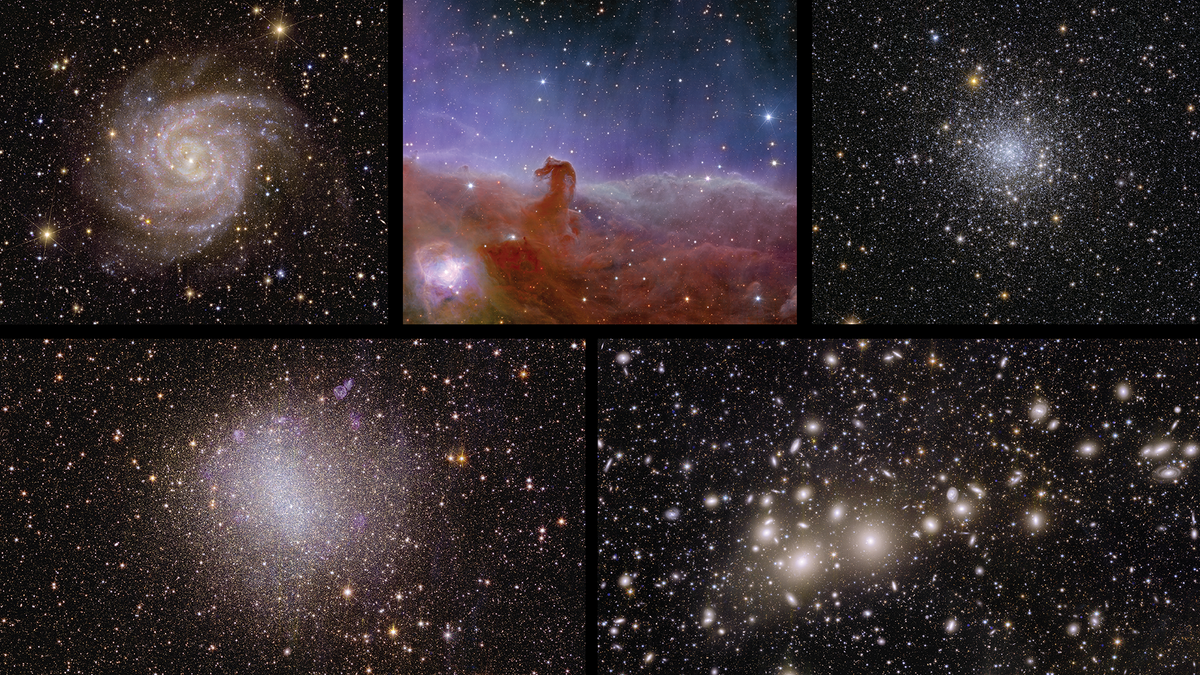
Editor’s Note: Images of the new Euclid Telescope were released at 5:00 a.m. EDT (1200 CET). You can see the five new views of the universe here on our website Photo release story.
The European Space Agency (ESA) will release five new images from the Euclid Space Telescope today (May 23). Well, if the previous set of images are anything to go by, space enthusiasts should be in for an absolute treat.
“Five new images of our universe were taken during Euclid’s early observations, each revealing fascinating new science.” ESA officials said in a statement. “Euclid’s ability to uncover the secrets of the universe is something you won’t want to miss.”
The new images will be revealed at 5:00 AM EDT (1200 CEST) and will be accompanied by 10 stunning scientific papers. You can watch the data release live on ESA YouTube channel.
Related: Euclid’s ‘dark universe’ telescope is defrosting a million miles away
As an appetizer for the occasion, perhaps we can remind ourselves of the stunning cosmic images this mission has provided so far.
Euclid’s story so far
Euclid was launched on July 1, 2023, from Cape Canaveral in Florida aboard a SpaceX Falcon 9 rocket, a wide-angle space telescope carrying a 600-megapixel camera observing the universe in visible light, a near-infrared spectrometer and a photometer. Used to determine the redshift of galaxies. Knowing redshift allows scientists to know how fast distant galaxies are moving away from our planet.
Euclid’s primary mission is to explore the two most mysterious elements in the universe: dark energy and dark matter. Together, these phenomena form what is often called the “dark universe.”
Dark energy is the name given to any force that causes the expansion of the universe to accelerate. Dark matter, on the other hand, is a form of matter that is effectively invisible because it does not interact with light. This means that scientists know that “ordinary” matter made up of electrons, protons and neutrons is what makes up stars, planets, moons and our bodies. Dark matter can only make its existence known through its interactions with gravity, which in turn can affect ordinary matter and light. But to be clear, neither dark matter nor dark energy are necessarily the same thing. They can both be made of many things, or they may both actually be made of one homogeneous thing.
The point is that we simply don’t know.
However, dark energy is thought to make up about 68% of the universe’s energy and matter budget, while dark matter makes up about 27%. This means that the dark universe represents 95% of the things in the universe, and the things we actually understand only represent about 5%.
Therefore, he is dubbed the “Detective of the Dark Universe” due to his specific set of tools, and Euclid clearly has his work cut out for him. But it is certain that the first official images from the space telescope released on November 7, 2023, after its first four months in space, showed that it is up to the task.
Directly above is one of the first images the public saw from the Euclid Telescope. It’s a snapshot showing 1,000 or so galaxies, all of which belong to the Perseus cluster. Located about 240 million light-years from Earth, this cluster is one of the largest structures in the known universe.
Mapping galaxies at such huge sizes is key to understanding how dark matter is distributed and how this distribution affected the evolution of the universe.
In addition to the wealth of Perseus cluster galaxies, the image also showed 100,000 much more distant galaxies, each containing up to hundreds of billions of stars. Observing distant galaxies in large numbers like these is the key for Euclid to uncover how dark energy is pushing these galaxies apart faster and faster by accelerating the expansion of space between them.
Just because Euclid has his eyes on vast expanses of galaxies, doesn’t mean he can’t be impressed by pictures of individual galaxies.
One of the first Euclid images we came across was somewhat ironic for an instrument charged with revealing the dark elements of the universe. This is because it identified galaxy IC 342, also known as the “hidden galaxy.”
This galaxy is located about 11 million light-years from Earth, and is difficult to photograph because it lies behind the bright, dusty disk of the Milky Way. But that didn’t stop Euclid from taking a stunning photo of this once-hidden spiral galaxy. To do this, the space telescope used its near-infrared instrument, which is useful because the gas and dust in the Milky Way’s disk are less effective at absorbing infrared light than other wavelengths of electromagnetic radiation.
To uncover the secrets of the dark universe and create a detailed 3D map of the universe, Euclid would need to see galaxies up to 10 billion light-years away by seeing the 13.8 billion-year-old universe as it was less than 4 years ago. One billion years after the Big Bang.
These galaxies likely do not have the neat, swirl-like arrangement of the Milky Way or even the Hidden Galaxy. Most galaxies in the early universe are “blocky” galaxies, poorly shaped, irregular galaxies that served as building blocks for larger galaxies.
To prepare for observing these distant, early galaxies, Euclid’s first images included a view of the local irregular galaxy, NGC 6822, located just 1.6 million light-years from Earth.
Although it gives us stunningly bright images, Euclid won’t be focusing solely on galaxies during its mission.
As the image of NGC 6397 above shows, the space telescope will also observe globular clusters. Fortunately, the globular clusters are beautiful too. They are clumps of hundreds of thousands of stars bound together by gravity, and are some of the oldest structures in the known universe.
NGC 6397 is the second closest globular cluster to Earth at a distance of about 7,800 light-years. Globular clusters like NGC 6397 orbit the disk of the Milky Way and could contain clues regarding either the evolution of our galaxy, or at least other galaxies in which such structures exist.
Euclid will excel at studying globular clusters because, unlike other telescopes, it has a field of view wide enough to capture entire globular clusters in a single image, just as it did with NGC 6397.
Much of Euclid’s mission will focus on the unknown, but the final image from the first batch of Euclid publications actually showed us a familiar celestial body in a whole new light. Dark Universe Investigator has created an amazingly detailed panoramic view of the Horsehead Nebula, also known as Barnard 33.
The Horsehead Nebula is located about 1,380 light-years from Earth and lies near the east of Orion’s Belt, one of the closest star-forming clouds of gas and dust to the Solar System. It is also a sight to behold.
Although many telescopes have imaged the Horsehead Nebula in the past, none have been able to capture this region of the Orion molecular cloud in such a wide, sharp view. What is most surprising about this image is that it took Euclid only one hour of observation time to create it. It’s no wonder professional astronomers, amateurs, and space enthusiasts alike are excited about the upcoming data release on May 23.
To that end, although the detailed images above are impressive, there’s a good chance the best is yet to come from Euclid as he begins to achieve his mission goals while shedding an eerie light on the dark universe.
We’ll have to wait until early Thursday to see what the next set of Euclid images has to offer and to see how this investigator of the dark universe begins to live up to the expectations of his massive mission after nearly a year in space. But, again, if her past is any indication of her future, it’s hard to imagine anything besides informative beauty from these images.

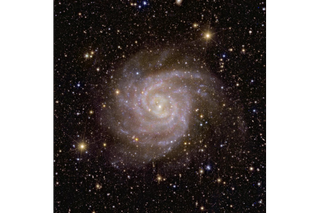
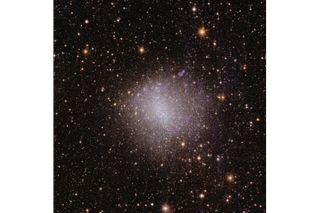
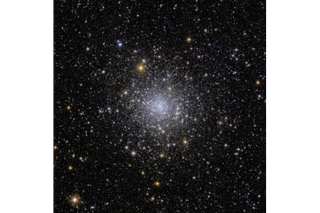
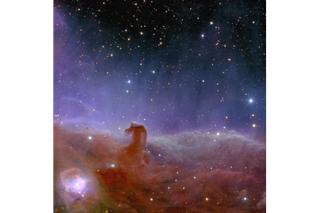



More Stories
Boeing May Not Be Able to Operate Starliner Before Space Station Is Destroyed
Prehistoric sea cow eaten by crocodile and shark, fossils say
UNC student to become youngest woman to cross space on Blue Origin